生物工程专业英语课件1科技英语基础知识及词汇
生物工程专业英语ppt课件
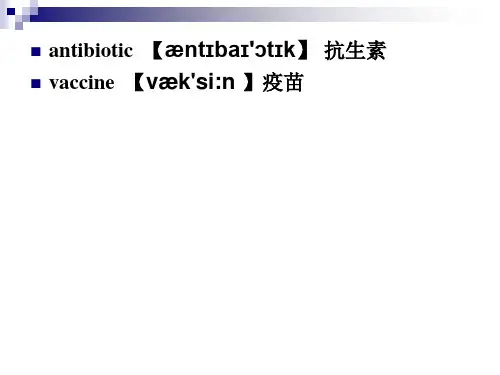
acetic 【 ə‘sitɪk 】酸的,醋酸的
acetic acid 乙酸
butanol 【 ‘bjutə,nol 】丁醇
acetone【 ‘æsə,ton 】丙酮 contaminate【 kən‘tæmə,net 】污染、毒害
我们无法确定这些微生物生产过程的出现是源于 偶然还是主观实验,但其进一步不断发展的早期 实例证明了人类能够利用微生物的生命活动来满 足自己的需要。
reliant 【 rɪ‘laɪənt 】依赖、依靠 proportion 【 prə‘porʃən 】比例、比率
humble 【‘hʌmb! 】低下的、卑微的 origin【‘ɔrədʒɪn】起源
其他的微生物过程,如奶酪和酸奶等发酵 乳制品的生产,以及酱油和豆豉等各种东 方食品的生产,都同样有悠久的历史。
Of more rencent introduction is mushroom cultivation which probably dates back many hundreds of years for Japanese shii-ta-ke cultivation and about 300 years for the Agaricus mushroom now widely cultivated throughout the temperate world.
formulate 【‘fɔ:mjuleit 】确切地阐述,
用公式表示
Anton van Leeuwenhoek安东尼·列文虎
克,荷兰博物学家,显微镜创造者
The recognition that these processes were being affected by living organisms, yeasts, was not formulated until the 17th century, by Anton van Leeuwenhoek.
生物工程专业英语单词

糖
sugar
tRNA
transferRNA
酶
enzyme
溶酶体
lysosome
R基
R-Group
细胞核
nucleus
生物体
organism
胰腺
pancreas
小分子
micromolecule
专业的;特化
specialized
有机物
organic
大分子
macromolecule
细胞器
organelle
电子
electron
延长、拉长
elongate
染色
stain
原子核
nucleus
完全相同的
identical
瘫痪
paralysis
复制、折叠
replicate
外显子
exon
杂交
hybridization
藻类
algae
内含子
intron
合成
synthetic
流行病学
epidemiology
终止子
terminator
遗传
inheritance
密码子
codon
固氮
fix nitrogen
相互作用
interaction
三联密码子
triplet
酿
brewing
核苷酸碱基
nucleotidebases
内质网
endoplasmic reticulum
A
Adenine
氨基酸
amino acid
杂种
mule
T
Thymine
简并性
生物工程专业英语-备课-2-科技英语的翻译
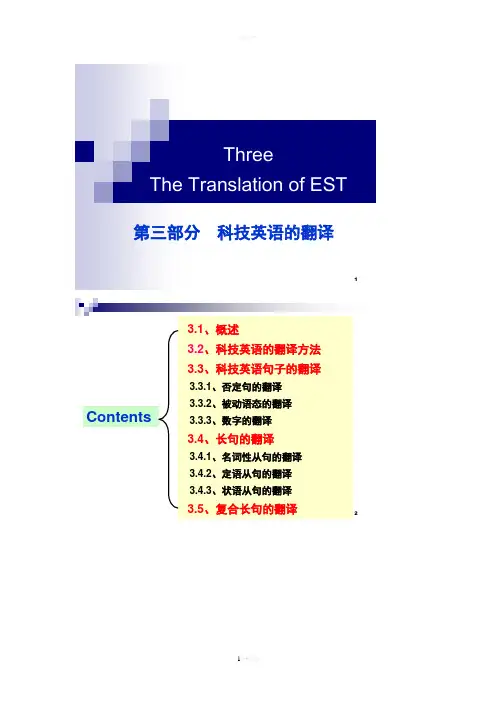
第三部分科技英语的翻译133.1、概述信、达、专业术语正确信、达、雅true smooth professional3.1.1 翻译标准4Ture ----准确无误地传达原文的真实含义包括:内容、精神、风格、文采…Smooth ----通顺地表达原文的含义➢句子规范➢符合汉语的表达➢不能逐词死译-----熟练掌握和运用一定的翻译方法和技巧-----较好的汉语功底⏹错误一:逐词翻译,以致译文生硬欧化⏹错误二:单纯追求译文通顺流畅而任意增删5➢科技英语翻译中,刻意追求的不是“雅”而是-----科学性+ 严谨性例:He wanted to learn, to know, to teach.他希望博学广闻,喜欢追根穷源,好为人师。
准:他想学习,增长知识,也愿意把知识教给别人。
➢一定要使用专业术语,不能说外行话例:the iron and steel industry铁和钢的工业准:钢铁工业63.1.2 汉、英句子基本类型对比⏹汉语注重语义结构,强调的是意义,不太强调句子的结构。
因此,汉语的句式非常复杂。
按结构可分为单句与复句。
单句有51种句式。
✓单句:(1) 主谓句(2) 非主谓句✓复句:(1) 单句直接组合成复句(2) 借助虚词构成复句无论英语句式如何变化,它们都由最基本的句子结构派生而成,这些基本结构称为基本句型。
英语中基本句型仅8种:⏹基本句型:➢ 1. 主语+谓语(He speaks.)➢ 2. 主语+谓语+状语(She lives here.)➢ 3. 主语+谓语+主语补语(主系表结构)(She is a kind woman.)7➢ 4.主语+谓语+直接宾语(We like English.)➢ 5.主语+谓语+直接宾语+状语(We can put the book on the table.)➢ 6. 主语+谓语+直接宾语+宾语补足语( I found the book useful.)➢7. 主语+谓语+间接宾语+直接宾语( He told him the news.)➢8. 主语+谓语+间接宾语(方向、目标)(We should serve the people.)89直译指基本保持原文表达形式及内容,同时要求语言通顺易懂,表述清楚。
生物工程专业英语1
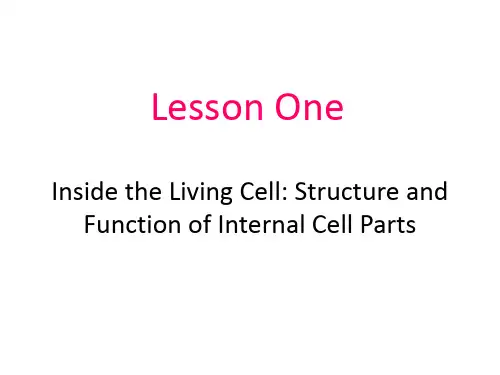
2.
The Nucleus: Information Central The eukaryotic cell nucleus is the largest organelle and houses the genetic material(DNA) on chromosomes. (In prokaryotes the hereditary material is found in the nucleoid.) The nucleus also contains one or two organelles-the nucleolithat play a role in cell division.
Glossary:
Cyto--- 细胞 Cytology:细胞学 Cytoplasm:细胞质 Cytokinesis:胞质分裂 Cytoskeleton:细胞骨架 Cytobiology:细胞生物学 Cytocentrum:中心体
chloroplast:叶绿体 chlorophyll:叶绿素 carotenoid:类胡萝卜素: carotene:胡萝卜素 lutein: 叶黄素 Accessory pigment: 辅助色素
• Ribosome 核糖体 • Small structures composed of two protein and ribonucleic acid subunits involved in the assembly of proteins from amino acids
The number of ribosomes within a cell may range from a few hundred to many thousands. This quantity reflects the fact that, ribosomes are the sites at which amino acids are assembled into proteins for export or for use in cell processes. 核糖体的数量变化从几百到几千,核糖体是氨基酸组 装成蛋白质的重要场所。
生物科学 专业英语第一课
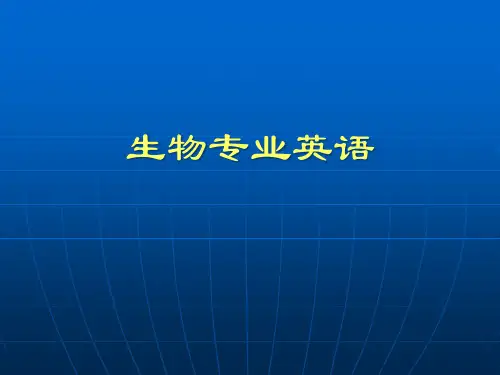
Actin 肌动蛋白 A globular contractile protein. In muscle
cells, actin interacts with another protein, myosein, to bring about contraction. Dynein 动力蛋白 A group of at least four distinct proteins found in the flagella and microtubules of eukaryotic cells and possessing ATPase activity. Myosin 肌球蛋白 A protein that, with actin, constitutes the principal element of the contractile apparatus of muscle.
Endoplasmic reticulum 内质网
Folded membranes and tubes throughout the eukaryotic cell that provide a large surface upon which chemical activities take place.
细胞的遗传亚结构
细胞核和染色体
Chromosome 染色体
A DNA-histone thread residing in the nucleus of a cell. Each chromosome possesses two telomeres and a centromere, and some contain a nucleous organizer. RNA proteins are invariably associated with the chromosome.
生物工程专业英语
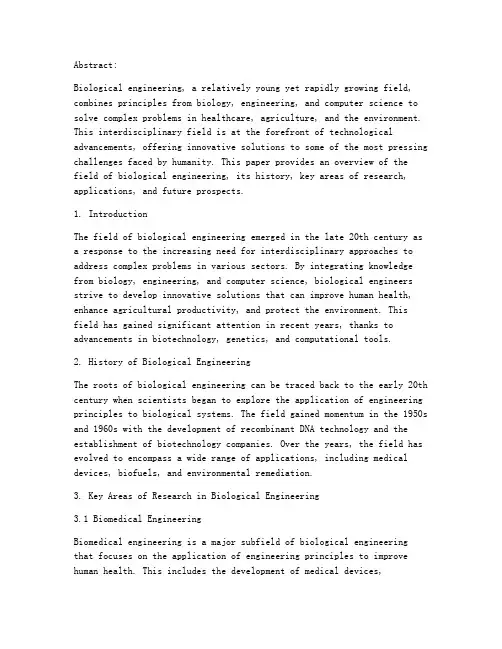
Abstract:Biological engineering, a relatively young yet rapidly growing field, combines principles from biology, engineering, and computer science to solve complex problems in healthcare, agriculture, and the environment. This interdisciplinary field is at the forefront of technological advancements, offering innovative solutions to some of the most pressing challenges faced by humanity. This paper provides an overview of the field of biological engineering, its history, key areas of research, applications, and future prospects.1. IntroductionThe field of biological engineering emerged in the late 20th century as a response to the increasing need for interdisciplinary approaches to address complex problems in various sectors. By integrating knowledge from biology, engineering, and computer science, biological engineers strive to develop innovative solutions that can improve human health, enhance agricultural productivity, and protect the environment. This field has gained significant attention in recent years, thanks to advancements in biotechnology, genetics, and computational tools.2. History of Biological EngineeringThe roots of biological engineering can be traced back to the early 20th century when scientists began to explore the application of engineering principles to biological systems. The field gained momentum in the 1950s and 1960s with the development of recombinant DNA technology and the establishment of biotechnology companies. Over the years, the field has evolved to encompass a wide range of applications, including medical devices, biofuels, and environmental remediation.3. Key Areas of Research in Biological Engineering3.1 Biomedical EngineeringBiomedical engineering is a major subfield of biological engineeringthat focuses on the application of engineering principles to improve human health. This includes the development of medical devices,diagnostic tools, and therapeutic agents. Some key areas of research in biomedical engineering include:- Tissue engineering: Developing bioartificial tissues and organs for transplantation.- Nanomedicine: Using nanotechnology to deliver drugs and imaging agents directly to diseased cells.- Biocompatibility: Ensuring that medical devices and implants are compatible with the human body.3.2 Biochemical EngineeringBiochemical engineering involves the design and optimization of processes that use biological systems to produce valuable products. This includes the development of industrial fermentation processes, enzyme engineering, and bioreactors. Some key areas of research in biochemical engineering include:- Bioprocessing: Developing efficient and sustainable methods for producing biofuels, pharmaceuticals, and other chemicals.- Enzyme engineering: Improving the properties of enzymes for industrial applications.- Bioreactor design: Optimizing the design of reactors to maximize the production of desired products.3.3 Environmental EngineeringEnvironmental engineering in biological engineering focuses on the development of technologies to protect and restore the environment. This includes the treatment of wastewater, air pollution control, and bioremediation. Some key areas of research in environmental engineering include:- Bioremediation: Using biological agents to clean up contaminated sites.- Wastewater treatment: Developing efficient methods for treating and recycling wastewater.- Air pollution control: Using biological systems to remove pollutants from industrial emissions.4. Applications of Biological Engineering4.1 HealthcareBiological engineering has revolutionized healthcare by developing new treatments, diagnostics, and medical devices. Some notable applications include:- Gene therapy: Using genetic engineering to treat genetic disorders.- Artificial organs: Developing bioartificial organs for transplantation.- Drug delivery systems: Using nanotechnology to deliver drugs directly to diseased cells.4.2 AgricultureBiological engineering has contributed to the development of sustainable agricultural practices that enhance crop yield and reduce environmental impact. Some key applications include:- Genetically modified organisms (GMOs): Developing crops with improved resistance to pests and diseases.- Precision agriculture: Using sensors and data analytics to optimize crop management.- Biopesticides: Developing environmentally friendly alternatives to chemical pesticides.4.3 Environmental ProtectionBiological engineering plays a crucial role in protecting the environment by developing technologies to remediate pollution and reduce waste. Some applications include:- Bioremediation: Using biological agents to clean up oil spills and contaminated sites.- Wastewater treatment: Developing sustainable methods for treating and recycling wastewater.- Air pollution control: Using biological systems to remove pollutants from industrial emissions.5. Future ProspectsThe field of biological engineering is expected to continue growing rapidly in the coming years, driven by technological advancements and increasing demand for sustainable solutions. Some future prospects include:- Development of personalized medicine: Tailoring treatments to individual patients based on their genetic makeup.- Advancements in biofuels: Developing more efficient and sustainable methods for producing biofuels.- Addressing global challenges: Using biological engineering to address issues such as climate change, food security, and water scarcity.6. ConclusionBiological engineering is a dynamic and rapidly evolving field that offers immense potential for solving complex problems in healthcare, agriculture, and the environment. By integrating knowledge from various disciplines, biological engineers are at the forefront of technological innovation, developing innovative solutions that can improve the quality of life for people around the world. As the field continues to grow, it is poised to play an even more significant role in shaping the future of humanity.。
生物工程专业英语
acid酸acidify酸性actinomycete放线菌adapability适应性adjunct辅助剂adjunctive therapy辅助治疗adsorbeacid酸acidify酸性actinomycete放线菌adapability适应性adjunct辅助剂adjunctive therapy辅助治疗adsorbent吸附剂adsorption吸附aeration通气,通风agar琼脂agarose gel琼脂糖凝胶agitation搅动alcohol醇,乙醇alga海藻algae(复)藻类alkalinity碱性amio氨基的ammonium铵amply扩增amylase淀粉酶anaerobe厌氧的analog类似物analogue类似物antibiotic抗生素antibiotic resistance抗生素抗性antibody抗体antifoam消泡剂antigen抗原apparatus仪器,器械archeologist考古学家aseptic无菌的bacterial细菌的bacteriophage噬菌体base pair碱基对batch一次生产量biodegredable可降解的bioinformatics生物信息学biomolecule生物分子biosensor生物传感器botany植物学brew酿造broth肉汤,发酵液bubble column bioreacter鼓泡塔式反应器buffer缓冲液,缓冲calcium钙carbohydrate碳水化合物carbonate碳酸盐catabolic分解代谢的cellulase纤维素酶cellulose纤维素centrfugal离心的,离心机centrifugation离心法,离心centrifuge离心机chemostat恒化器chitin几丁质chloroplast叶绿体chromatography色谱chromosome染色体citric acid柠檬酸clarification澄清clone克隆clone library克隆文库cloning vector克隆载体coefficient系数colony菌落colorimeter比色计comparison比较,对照complementrary互补的component成分,组分composition组成compound化合物concentration浓缩,浓度conformation构象contamination污染,污染物crystallisation结晶化decomposition分解,腐烂decontaminate净化deficient缺乏的degrade降解,降级deplete使衰竭,耗尽deposite沉淀物,沉淀detoxification解毒devoid缺乏的dextran葡萄糖diameter直径digest消化,酶切diluent稀释的,稀释液dilute稀释dilution稀释disintegrant崩解剂disintegration瓦解dissociate解里,游离dissolve溶解double helix双螺旋double stranded双链的downcomer下流管,溢流管,液降duplicate使重复,复制electrophoresis电泳enzyme酶eradication根除eukaryote真核细胞exaggerate使增大,使夸大exceed超过,胜过expertise专门技术expression vector表达载体extracellular细胞外的fabricate虚构,制作,伪造feedback反馈fermentation发酵fermenter发酵罐filter过滤,过滤器filtration过滤flask烧瓶。
生物科学专业英语第一课
Organelles are suspended within it, supported by the filamentous network of the cytoskeleton.
Dissolved in the cytoplasmic fluid are nutrients, ions, soluble proteins, and other materials needed for cell functioning.
found in the flagella and microtubules of eukaryotic cells and possessing ATPase activity.
Myosin 肌球蛋白 A protein that, with actin, constitutes the
principal element of the contractile apparatus of muscle.
Nuclear envelope 核膜,核被膜 A double membrane (two lipid bilayers
and associated proteins) that is the outermost portion of a cell nucleous. Nucleoid 核质体 The DNA-containing area of a prokaryote cell, analogous to eukaryote nucleus but not membrane bounded.
Stroma 子座,基质
Region within a chloroplast that has no chlorophyll.
Plastid 质体
生物工程(生物技术)专业英语翻译
生物工程(生物技术)专业英语翻译Lesson One(4学时)Inside the Living Cell: Structure andFunction of Internal Cell Parts教学目的:使学生掌握细胞的组成结构(各种细胞器以及它们在细胞中的位置),Cytoplasm: The Dynamic, Mobile Factory细胞质:动力工厂Most of the properties we associate with life are properties of the cytoplasm. Much of the mass of a cell consists of this semifluid substance, which is bounded on the outside by the plasma membrane. Organelles are suspended within it, supported by the filamentous network of the cytoskeleton. Dissolved in the cytoplasmic fluid are nutrients, ions, soluble proteins, and other materials needed for cell functioning.生命的大部分特征表现在细胞质的特征上。
细胞质大部分由半流体物质组成,并由细胞膜(原生质膜)包被。
细胞器悬浮在其中,并由丝状的细胞骨架支撑。
细胞质中溶解了大量的营养物质,离子,可溶蛋白以及维持细胞生理需求的其它物质。
2The Nucleus: Information Central(细胞核:信息中心)The eukaryotic cell nucleus is the largest organelle and houses the genetic material (DNA) on chromosomes. (In prokaryotes the hereditary material is found in the nucleoid.) The nucleus also contains one or two organelles-the nucleoli-that play a role in cell division. A pore-perforated sac called the nuclear envelope separates the nucleus and its contents from the cytoplasm. Small molecules can pass through the nuclear envelope, but larger molecules such as mRNA and ribosomes must enter and exit via the pores.真核细胞的细胞核是最大的细胞器,细胞核对染色体组有保护作用(原核细胞的遗传物质存在于拟核中)。
生物专业英语ppt讲解材料
Review Articles
These articles synthesize and evaluate research on a particular topic, providing an overview of the current state of knowledge.
Technical Reports
01
introduction
Purpose and background
Purpose
To provide a comprehensive overview of the field of biology, focusing on key concepts, principles, and applications.
Sentence structure and expression
Active Voice
Using active voice, especially in scientific writing, makes sentences more direct and easier to understand.
The study of heredity and the variation of traits within and between species.
Evolutionary Biology
Ecology
Biotechnology
The study of the origin and development of species through natural selection and other mechanisms.
These are written to communicate technical information in a clear and concise manner, often including tables, figures, and appendices.
- 1、下载文档前请自行甄别文档内容的完整性,平台不提供额外的编辑、内容补充、找答案等附加服务。
- 2、"仅部分预览"的文档,不可在线预览部分如存在完整性等问题,可反馈申请退款(可完整预览的文档不适用该条件!)。
- 3、如文档侵犯您的权益,请联系客服反馈,我们会尽快为您处理(人工客服工作时间:9:00-18:30)。
1 2Course Property⏹生物工程专业英语属于科技英语的范畴。
既不同于普通英语,也不同于专业课的英语教学。
专业英语是本科生在完成两年的基础英语学习后开设的一门后继课程。
⏹普通英语是专业英语的基础,专业知识是其背景,专业英语在词汇、语法、句法等方面都有专业的特色。
3Teaching Aims⏹一方面了解科技英语在词汇、语法和句式等方面的特点,掌握科技英语的阅读、翻译及写作等基本技能⏹另一方面通过指导阅读一些有关生物工程专业的英语文摘和文献,使学生掌握一定的阅读和翻译科技文献的方法,提高以英语为工具获取本专业的信息和资料的能力。
4⏹English for Science and Technology (EST )➢The features of EST ➢The vocabulary of EST ➢The translation of EST ➢The writing of EST ⏹围绕科技英语本身,就一些科技英语在词汇、语法、阅读、翻译的特点,以及一些简单的摘要写作和惯用表达方法等进行讲解,使大家对科技英语的有关知识有一定的了解和掌握。
Teaching Contents (One)5⏹Specialized English in Biotechnology ➢Chapter 1Introduction ➢Chapter 2Biochemistry of Growth and Metabolism ➢Chapter 3Applied Genetics ➢Chapter 4Fermentation Technology ➢Chapter 5Enzyme and Immobilized Cell Technology ➢Chapter 6Downstream Processing in Biotechnology ➢Chapter 7Instrumentation ➢Chapter 8Processes and Products Dependent on Cultured Animal Cells ➢Chapter 9Products from Plant Cells Teaching Contents (Two)⏹对生物工程的有关材料进行阅读,掌握一定量的专业词汇,提高大家阅读专业英语文献的能力。
6⏹指定教材:邬行彦,《生物工程/生物技术专业英语》,化学工业出版社⏹参考教材:➢任胜利,《英语科技论文撰写与投稿》,科学出版社➢宋天锡、任英,《英语应用文写作》,中国书籍出版社➢秦荻辉,《实用科技英语写作技巧》,上海外语教育出版社➢范武邱,《实用科技英语翻译讲评》,外文出版社⏹考试方式:期末考试成绩*60%+平时成绩*40%IllustrationEnglish for Science andTechnology(EST)7One The features of EST第一部分科技英语的特点⏹1.1、体会、比较不同的英文文体⏹1.2、科技英语的特点⏹1.3、科技英语的常用句式8(Two)She was of a helpless, fleshy build, with a frank, open countenance and an innocent, diffident manner. Her eyes were large and patient, and in them dwelt such a shadow of distress as only those who have looked sympathetically into the countenances of the distraught and helpless poor know anything about.那妇人生着一副绵软多肉的体格,一张坦率开诚的面容,一种天真羞怯的神气。
一双大落落的柔顺眼睛,里边隐藏着无穷的心事,只有那些对于凄惶无告的穷苦人面目作过同情观察的人才看得出来。
这是一段非常优美生动的文学片段。
五十一个词的片段,就运用了十个形容词,占五分之一。
101.1、体会、比较不同文体特点(One)A: "It appears that you've got the offer of a very good job."B: "A wonderful job."A: "Are you going to take it ?"B: "I don't think so."A: "Why not?'B: "I don't want to."A: “听说有个很好的工作要你去干。
”B:“挺好的工作。
”A: “打算干吗?”B: “不。
”A: “为什么不干?”B:“不想干。
”这是小说中的一段对说,属于口语文体。
其特点是:用词自由,句法结构简单,短句与省略句多,自然朴素,生活气息浓厚。
9(Three)Enzyme technology.Isolated enzymes have long been a part of many biotechnological processes and their catalytic properties are being further utilized with the development of suitable immobilization techniques allowing reuse of the biocatalyst. A further development is the immobilization of whole cells for biocatalytic purposes.酶技术. 分离酶长久以来都用在生物生产中,它们的催化能力也在进一步被开发利用,固定化技术迅速发展得以使酶能够重复使用。
将整个细胞固定化作为生物催化剂是下一步的发展方向。
111.2、科技英语的特点➢科技英语是指科技文体,包括英语科技论文、科技报告、科普文章、科技新闻和科研产品说明书等,它有别于一般英语和文学英语。
➢科技文体崇尚结构严谨、概念准确、逻辑性强、行文简练、推理周密、重点突出、句式严整、段落章节分明。
➢比起非科技英语, 科技英语有以下特点:1213(1) 复杂长句(Long Sentences)多科技文章要求客观、具体、叙述准确、推理严谨,因此科技英语中常使用长句,一句话里经常包含三四个甚至五六个分句。
译成汉语时,必须按照汉语习惯分解成适当数目的分句,才能条理清楚。
长句可用两种方法使之简化,以便正确理解。
➢①依据谓语动词把复合句分解为一组简单句。
➢②依据关键词简化各词组。
14⏹ExampleBiotechnology is an area of applied bioscience and technology which involves the practical application of biological organisms, or their subcellular components to manufacturing and service industries and to environmental management.⏹Analysis:Biotechnology is an area of applied bioscience and technology. Area involves the practical application of …….这些分句的意义是不难理解的。
然后把它们有机地组合起来,并恢复其他辅助成分,则可把全句译为:生物工程是属于应用生物科学和技术的一个领域,它包含生物或其亚细胞组分在制造业、服务业和环境管理等方面的应用。
15科技人员在研究和解决科技问题时重视事物本身的客观规律、主观事实和方法、性能和特征,在讨论科技问题是力求客观而准确的陈述,因此,在科技文献中通常以非人称的语气作客观的叙述,从而较多使用被动句。
因此,应该从广义上来理解生物化学和化学以及他们与生物技术的关系。
(2) 被动语态多Example :Thus the interface between bioscience and chemistry and its relationship to biotechnology must be broadly interpreted .16英语语法有一条特定要求,即在英语的每个简单句中只能有一个谓语动词,如果读到几个动作,就必须选出主要动作当谓语,而将其余动作用非谓语动词形式,才能符合英语语法要求。
这就是英语为什么不同于其他语言,有非谓语动词,而且在科技英语中用得十分频繁的原因。
非谓语动词有三种: 动名词、分词(包括现在分词、过去分词)和不定式。
(3) 非谓语动词多17例要成为一个名副其实的内行,需要学到老。
这句中,有“成为”、“需要”、“学”三个表示动作的词,本句译成英语:To be a true professional requires lifelong learning .可以看出,选“需要(require)”作为谓语,其余两个动作中的“成为”用不定式形式to be ,“学”用动名词形式learning ,这样才能符合英语语法的要求。
例把水加热并不会改变水的化学成分。
本句有两个动作,即“加热”和“改变”,译成英语:Heating water does not change its chemical composition.本句将“改变”用作谓语,而将“加热”(heating)处理为动名词,连同其宾语water 作为本句主语。
18英语单词有不少是多性词: 既是名词,又可作动词、形容词、介词等。
例above介词: above all (things) 首先,最重要的是形容词: for the above reason 由于上述原因副词: as (has been) indicated above 如上所指出(4) 词性转换多20(5)表达方式程式化⏹文章结构程式化:标题、摘要,正文(引言、论述、结论)。
⏹介绍某个过程或功能及达到某种目标时,一般利用动词不定式短语构成目的状语,放在句子开头。
例:To increase the rate of reaction, a catalyst is used.⏹简述实验结果时,往往在句首使用引导词it 作形式主语,构成被动句,例:It was found the rate of follow was improvedby increasing the pressure.19例light名词: (启发) in (the) light of 由于,根据(光) high light(s) 强光,精华(灯) safety light 安全指示灯形容词: (轻) light industry 轻工业(明亮) light room 明亮的房间(淡) light blue 淡蓝色(薄) light coating 薄涂层(6)条件句多⏹科技英语中常须提出假设和推理,因而条件句使用得较多。
